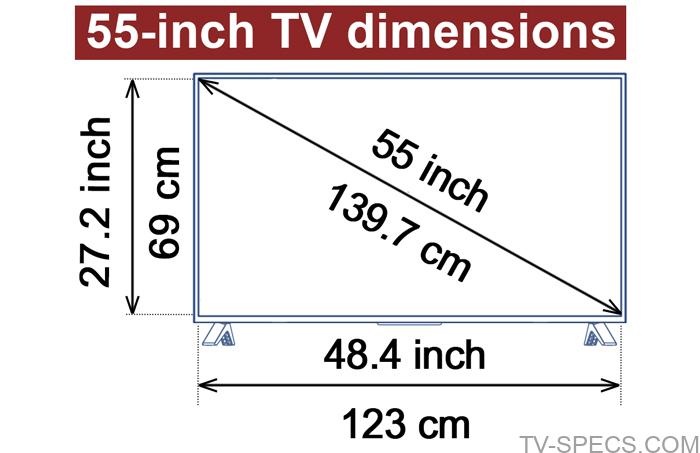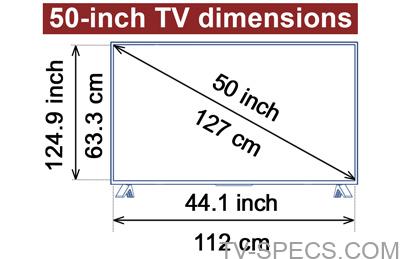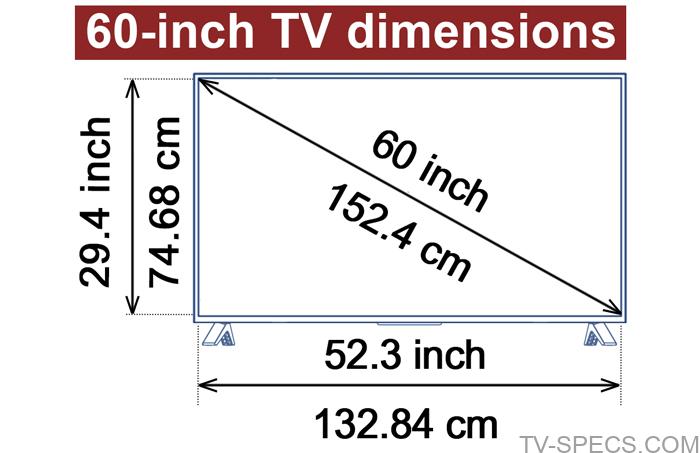If you need an answer to the question “What Size TV Should I Get?” then you have my article for you. This guide aims to assist you in selecting the ideal TV size that suits your requirements, budget, and the dimensions of the room, by compiling all my expert recommendations. While primarily intended for choosing a TV for your family room, these principles can be applied to selecting right size for your space: bedroom, kitchen, or office as well.

Key moments
- If you want the best possible watching experience, you should look for a television that is within 30 to 40 degrees of your field of view while making your purchase.
- In general, the screen of the television need to be proportionally bigger if it is to accommodate a greater viewing distance.
- The most prevalent size of the TV in North American homes is now 55 inches, but analysts predict that this will rise to 65 inches during the next five years as more people buy larger televisions.
- Mounting a television enables you to disregard size limits imposed by an entertainment system, which otherwise would have an effect on the standard TV you choose to purchase.
Well, what you prefer to watch, the resolution of the TV, how far you sit from the screen, the angle at which you watch it, and how much money you have – all this is a short answer to the question. To make the right choice, you should consider several important factors. There is everything you need to know in my article.
What sizes of TVs exist
When it comes to televisions, there is no such thing as a universal model that can accommodate all needs. There are also just a select few sizes available on the market since TV manufacturers are constrained in the ways that display manufacturers can cut the screen. This results in a restricted number of available sizes. At the moment, televisions are available with the following resolution increments:
- 32 inches
- 40 inches
- 43 inches
- 50 inches
- 55 inches
- 60 inches
- 65 inches
- 70 inches
- 75 inches
- 80 inches
- 85 inches
How to Choose Ideal Screen Size for a Room?
You will need to choose where you want your television to be placed before you can choose between an LCD TV, an OLED TV, or an Ultra HD TV.
After selecting the spot, take measurements of its height, width, and depth, considering any constraints imposed by the available space on the wall or the size of the entertainment center.

During the shopping process, you can compare the measurements of the TV itself (not just its screen size) with the measurements of the chosen spot to ensure that it fits properly.
Right Size TV for Your Space
Because living spaces do not expand to make room for larger televisions, it is important to choose a set that is proportionate to its setting. The ideal viewing distance is directly proportional to the size of the screen being seen. When viewing content on a screen with a larger surface area, it is recommended to the TV stand some distance away from the screen. If you sit closer to a TV, you may notice undesirable distortions and color abnormalities.
Think about the space in which you want to set up the TV. You have some wiggle space in terms of the best size of the television you may purchase for that room so long as the furniture there is not firmly fixed to the floor and you are prepared to shift it about.
Room Size and TV Position
Your first step is to choose whether or not you want it to be hung on the wall. You really must be aware of this prior to going to the store or shopping for an HDTV on the Internet.
The viewing distance will be reduced, and there may be concerns with the viewing angle if the television is placed on top of an entertainment center. Additionally, the size of the cabinet may place restrictions on the amount of space available for either a flat or curved display.

If your cabinet is on the smaller side, a large display could appear out of place, and weight restrictions might prevent you from using some displays. On the other hand, a lengthy cabinet could make a nice-sized TV seem less impressive when compared to its surroundings.
Be careful to take the cabinet’s length and width measurements before installing a stand mount if you have those plans. Despite the fact that modern flat screens weigh significantly less than their predecessors, it is still a good idea to find out how much weight your cabinet can accommodate.

The aspect ratio of all current televisions is 16:9, and the typical weight of a flat screen television is somewhere about 45 pounds. The weight, on the other hand, may fluctuate wildly depending on the kind of display and the dimensions of the screen. The versions with edge-lit LEDs are the lightest, while an Ultra HDTV is the one with the most weight.
It’s possible that an LED of a more moderate size may weigh as little as 25 pounds. On the other end of the scale, a 75-inch Ultra HD quality QLED or OLED television weighs around 50 or more pounds on average.
Screen Size and Viewing Distance: How to Calculate TV Size
Viewing distance and screen size are closely related. The general rule of thumb that applies to the relationship between viewing distance and the size of your TV is that the more away you are from the television, the larger screen size will need to be. In general, people have a field of view that is 200 degrees, and the optimal placement of television is anywhere between 30-40 degrees off of the center of your view, depending on the sort of media you choose to take in.

For instance, the Society of Motion Picture and Television Engineers (SMPTE) has issued one of the recommendations that is most often referenced in the industry. It proposes a distance from which a display would occupy a field of vision that is 30 degrees in diameter. This distance is about equivalent to 1.62 times the size of the display on a television.
SMPTE Recommended Distance from Optimal Screen Size
In the table, I have minimized the most common smart TV sizes and led the recommended distance.
Screen Size | SMPTE Maximum |
30 | 4.1 feet (1.2 m) |
32 | 4.4 feet (1.3 m) |
40 | 5.4 feet (1.6 m) |
43 | 5.8 feet (1.8 m) |
45 | 6.1 feet (1.9 m) |
48 | 6.5 feet (2 m) |
50 | 6.8 feet (2.1 m) |
55 | 7.5 feet (2.3 m) |
60 | 8.2 feet (2.5 m) |
65 | 8.8 feet (2.7 m) |
70 | 9.5 feet (2.9 m) |
75 | 10.2 feet (3.1 m) |
80 | 10.9 feet (3.3 m) |
85 | 11.6 feet (3.5 m) |
90 | 12.2 feet (3.7 m) |
100 | 13.6 feet (4.1 m) |
SMPTE Recommended Maximum Distance Given Screen Size and Resolution
Screen Size | 720p (1280 x 720 pixels) | 1080p (1920 x 1080 pixels) | 4K (3840 x 2160 pixels) |
30 | 5.9 feet (1.8 m) | 3.9 feet (1.2 m) | 1.9 feet (0.6 m) |
32 | 6.3 feet (1.9 m) | 4.2 feet (1.3 m) | 2 feet (0.6 m) |
40 | 7.8 feet (2.4 m) | 5.2 feet (1.6 m) | 2.6 feet (0.8 m) |
43 | 8.4 feet (2.6 m) | 5.6 feet (1.7 m) | 2.8 feet (0.9 m) |
45 | 8.8 feet (2.7 m) | 5.9 feet (1.8 m) | 2.9 feet (0.9 m) |
48 | 9.4 feet (2.9 m) | 6.2 feet (1.9 m) | 3.1 feet (0.9 m) |
50 | 9.8 feet (3 m) | 6.5 feet (2 m) | 3.2 feet (1 m) |
55 | 10.8 feet (3.3 m) | 7.2 feet (2.2 m) | 3.5 feet (1.1 m) |
60 | 11.8 feet (3.6 m) | 7.8 feet (2.4 m) | 3.8 feet (1.2 m) |
65 | 12.7 feet (3.9 m) | 8.5 feet (2.6 m) | 4.2 feet (1.3 m) |
70 | 13.7 feet (4.2 m) | 9.1 feet (2.8 m) | 4.5 feet (1.4 m) |
75 | 14.7 feet (4.5 m) | 9.8 feet (3 m) | 4.8 feet (1.5 m) |
80 | 15.7 feet (4.8 m) | 10.4 feet (3.2 m) | 5.1 feet (1.6 m) |
85 | 16.7 feet (5.1 m) | 11.1 feet (3.4 m) | 5.4 feet (1.6 m) |
90 | 17.6 feet (5.4 m) | 11.7 feet (3.6 m) | 5.8 feet (1.8 m) |
100 | 19.6 feet (6 m) | 13 feet (4 m) | 6.4 feet (2 m) |
I want to emphasize that my recommendations are based on personal preferences because someone will want to sit close to the TV but for you it’s maybe more comfortable to be away from your TV.
How to Measure TV Size?
Measuring TV size can be a simple process. Firstly, select the right TV screen size in inches, which is usually displayed on the TV box or specification sheet. To measure the screen size, place a measuring tape or ruler diagonally from the bottom left corner to the top right corner. Ensure that the measuring tape or ruler is tight to get accurate measurements.

Alternatively, measure the width and height of the TV screen and use the Pythagorean theorem to calculate the diagonal size. For instance, if the width is 35 inches and the height is 20 inches, the diagonal size screen would be approximately 40 inches. It’s important to measure the TV’s size accurately to ensure the appropriate viewing distance and to prevent any inconvenience in the placement of the device in the room. Overall, measuring TV size is a straightforward process that requires basic math skills and a measuring tape.
Is It Possible for A TV Size to Be Too Big?
If it was a joke, I’d say “NO”, but because we’re being serious, the answer will be “YES.” My recommendation would be to get a television that is as large as your finances would permit. Complaints from customers who now regret not going with a large screen size are something that comes up very regularly. It is amazing how fast one can get used to the biggest size TV.
Having said that, we are cognizant of the fact that not everyone has the financial means to purchase the largest television available. Even if you have enough budget, there is a chance that you do not have enough room in your lounge to accommodate it, or that it would be a terrible fit for the atmosphere there. You could also have a spouse who isn’t fond of a giant screen, or you might just think that a super-sized TV is intrusive and tacky. Either way, there are a few potential scenarios that might arise.
FAQ
Conclusion
On average, individuals who watch TV position themselves at a distance of 9 feet from the screen to ensure a comfortable viewing experience. This preference is due to the desire to sit far enough from the TV so that individual pixels on the screen cannot be discerned. Therefore, when deciding where to place your new TV, it is recommended to experiment with different positions and consider opting for a slightly larger screen than initially planned.
So, to get an answer to the question “What size TV should I buy?”, first follow my recommendations:
- You need to make sure that the television you purchase is large enough to occupy the area on the wall or entertainment center where it will be mounted.
- You need to take the measurements of the room you want to fill from corner to corner (TVs are measured diagonally), and then purchase the ideal screen size that corresponds to the dimensions of the room.
- You should consider that a minimum of 30-40 degrees of your field of view should be taken up by the television. For instance, if you watch TV from a distance of 7-8 feet away, the best screen size TV you should buy is a 55-inch TV; however, purchasing a biggest TV (such as 65-inch TV) would also be good.
READ ALSO:
55 Inch TV Dimensions
50 Inch TV Dimensions
60 Inch TV Dimensions
Tell us how can we improve this post?
Hi! I’m Henry Stanley. Welcome to my website!
With a background in technology journalism and a passion for personal technology and gadgets, I have spent the past decade staying up-to-date on the latest trends and advancements in the industry. My expertise extends to all brands of televisions, from compact models perfect for small apartments to massive screens that can transform any living room into a home theater.
I strive to provide my readers with the most accurate and comprehensive information.








